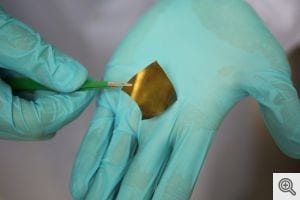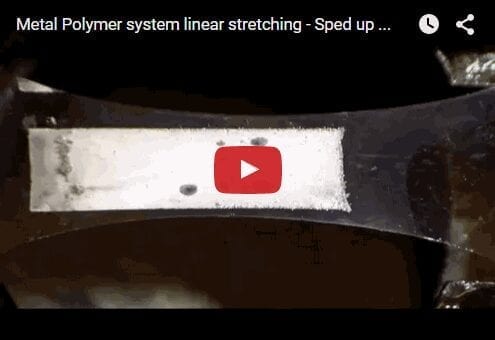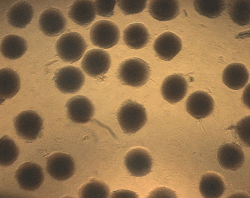
Flexible electronics have a wide variety of possibilities, from bendable displays and batteries to medical implants that move with the body.
Networks of spherical nanoparticles embedded in elastic materials may make the best stretchy conductors yet, engineering researchers at the University of Michigan have discovered.
Flexible electronics have a wide variety of possibilities, from bendable displays and batteries to medical implants that move with the body.
“Essentially the new nanoparticle materials behave as elastic metals,” said Nicholas Kotov, the Joseph B. and Florence V. Cejka Professor of Engineering. “It’s just the start of a new family of materials that can be made from a large variety of nanoparticles for a wide range of applications.”
Finding good conductors that still work when pulled to twice their length is a tall order—researchers have tried wires in tortuous zigzag or spring-like patterns, liquid metals, nanowire networks and more. The team was surprised that spherical gold nanoparticles embedded in polyurethane could outcompete the best of these in stretchability and concentration of electrons.
“We found that nanoparticles aligned into chain form when stretching. That can make excellent conducting pathways,” said Yoonseob Kim, first author of the study to be published in Nature on July 18 and a graduate student in the Kotov lab in chemical engineering.
To find out what happened as the material stretched, the team took state-of-the-art electron microscope images of the materials at various tensions. The nanoparticles started out dispersed, but under strain, they could filter through the minuscule gaps in the polyurethane, connecting in chains as they would in a solution.
“As we stretch, they rearrange themselves to maintain the conductivity, and this is the reason why we got the amazing combination of stretchability and electrical conductivity,” Kotov said.
The team made two versions of their material—by building it in alternating layers or filtering a liquid containing polyurethane and nanoparticle clumps to leave behind a mixed layer. Overall, the layer-by-layer material design is more conductive while the filtered method makes for extremely supple materials. Without stretching, the layer-by-layer material with five gold layers has a conductance of 11,000 Siemens per centimeter (S/cm), on par with mercury, while five layers of the filtered material came in at 1,800 S/cm, more akin to good plastic conductors.
The eerie, blood-vessel-like web of nanoparticles emerged in both materials upon stretching and disappeared when the materials relaxed. Even when close to its breaking point, at a little more than twice its original length, the layer-by-layer material still conducted at 2,400 S/cm. Pulled to an unprecedented 5.8 times its original length, the filtered material had an electrical conductance of 35 S/cm—enough for some devices.
Kotov and Kim chiefly see their stretchable conductors as electrodes. Brain implants are of particular interest to Kotov.
“They can alleviate a lot of diseases—for instance, severe depression, Alzheimer’s disease and Parkinson’s disease,” he said. “They can also serve as a part of artificial limbs and other prosthetic devices controlled by the brain.”
Rigid electrodes create scar tissue that prevents the electrode from working over time, but electrodes that move like brain tissue could avoid damaging cells, Kotov said.
“The stretchability is essential during implantation process and long-term operation of the implant when strain on the material can be particularly large,” he said.
Whether in the brain, heart or other organs—or used for measurements on the skin—these electrodes could be as pliable as the surrounding tissue. They could also be used in displays that can roll up or in the joints of lifelike “soft” robots.
The Latest Bing News on:
Flexible electronics
- Flexible pseudocapacitor defies climate extremes, packs energy punchon May 8, 2024 at 7:40 am
In today's rapidly evolving technological landscape, the demand for reliable energy storage solutions has never been greater. With our reliance on electronic devices growing, especially in aviation, ...
- Flexible Electronics Market To Reach USD 59.9 Billion By 2032, Says DataHorizzon Researchon May 3, 2024 at 12:00 am
Demand for wearable devices boosts the flexible electronics industry's growth. The fusion of wearable technology with flexible electronics stands as a significant technological advancement in recent ...
- Foundry Model For Flexible Chip Designon April 30, 2024 at 1:47 am
Discover how a shift to the foundry business model, traditionally reserved for silicon chip production, is revolutionizing the world of flexible electronics.
- Flexible Electronics: Transforming Cars, Homes, and Healthcareon April 28, 2024 at 6:31 pm
Imagine a car interior with sleek touch panels and heated windows, or a home where lights respond to your presence and fridge labels warn you about spoiled ...
- Stretchy power! Wearables get flexible energy storage in new breakthroughon April 25, 2024 at 5:10 am
Researchers have made a significant leap forward in addressing this challenge with the development of a small-scale energy storage device capable of stretching, twisting, folding, and wrinkling. This ...
- New research demonstrates potential of thin-film electronics for flexible chip designon April 24, 2024 at 8:00 am
The mass production of conventional silicon chips relies on a successful business model with large "semiconductor fabrication plants" or "foundries." New research by KU Leuven and imec shows that this ...
- Opening up the potential of thin-film electronics for flexible chip designon April 23, 2024 at 5:00 pm
The mass production of conventional silicon chips relies on a successful business model with large 'semiconductor fabrication plants' or 'foundries'. New research by shows that this 'foundry' model ...
- A new dawn for flexible electronics: Eliminating energy wasteon March 25, 2024 at 1:38 pm
This breakthrough promises flexible electronics capable of reliable performance at lower power levels and substantially reduced energy loss, with the five-stage ring oscillators showcasing ...
- Flexible electronics transform technology with bendable deviceson March 9, 2024 at 4:39 am
The realm of flexible electronics is not limited to plastic substrates alone. Innovations have introduced an array of materials, including textiles, ultra-thin glass, and even paper. These substrates ...
- MycelioTronics: Biodegradable Electronics Substrates From Fungion January 6, 2023 at 4:04 am
Traces are then cut via laser ablation. The resulting substrate is flexible and can withstand over 2000 bending cycles, which may prove useful in flexible electronics applications.
The Latest Google Headlines on:
Flexible electronics
[google_news title=”” keyword=”flexible electronics” num_posts=”10″ blurb_length=”0″ show_thumb=”left”]
The Latest Bing News on:
Elastic electronics
- Automotive Electronicson May 6, 2024 at 4:59 pm
Molex has introduced MX-Dash, a family of single automotive connectors that combine power, signal and high-speed data inserts for zonal architectures. In wire-to-wire and wire-to-board form, they are ...
- Thiol-ene click reaction offers a novel approach to fabricate elastic ferroelectricson April 26, 2024 at 6:23 am
Li Runwei and Hu Benlin at the Ningbo Institute of Materials Technology and Engineering (NIMTE) of the Chinese Academy of Sciences has developed a facile and efficient approach to fabricate elastic ...
- Two-dimensional nanomaterial sets expansion recordon April 16, 2024 at 5:01 pm
As tension is applied across the elastic nanosheet in one direction ... in the environment and sends the information to other electronics. Another application is embedding the material right ...
- Elastic Adds Support for Cohere High-Performance Embeddingson April 3, 2024 at 1:03 am
SAN FRANCISCO--(BUSINESS WIRE)--Elastic (NYSE: ESTC), the company behind Elasticsearch®, today announced the Elasticsearch open Inference API now supports Cohere’s text embedding models.
- MEI Methode Electronics, Inc.on January 18, 2024 at 12:43 am
Methode Electronics, Inc. designs ... which incorporate magneto-elastic sensing, eddy current, or other sensing technologies that monitor the operation or status of a component or system.
- Electronics storeson December 30, 2023 at 3:23 pm
Electronics store Ratings Find the top deals on gadgets and devices at the best electronics stores. From computers to cameras and even home appliances, electronics stores carry many must-haves.
- 14 Best Cord Organizer Travel Bags: Streamline Your Journeyon December 20, 2023 at 2:34 am
Organizes gadgets of all sizes with its versatile storage solution Hard molded outer case protects fragile electronics such as portable hard drives 8.3 x 4.3 x 2 inches to fit in a backpack or purse ...
- Elasticity vs. Inelasticity of Demand: What's the Difference?on March 5, 2023 at 4:53 am
Other factors include income level and substitute availability. Goods and services are elastic when demand changes for them in the economy. They become inelastic when demand remains relatively ...
- Electronics Dealson April 8, 2022 at 1:45 pm
We independently review everything we recommend. When you buy through our links, we may earn a commission. Learn more› Wirecutter’s experts spend hundreds of hours testing TVs, headphones ...
- How To Design Your Bedroom For A Better Night's Sleepon April 29, 2019 at 11:00 am
Remove excessive books, electronics, unfolded laundry ... As we age, skin becomes less elastic which increases sensitivity at pressure points. So softer, more “plush” mattresses may be ...
The Latest Google Headlines on:
Elastic electronics
[google_news title=”” keyword=”Elastic electronics” num_posts=”10″ blurb_length=”0″ show_thumb=”left”]











